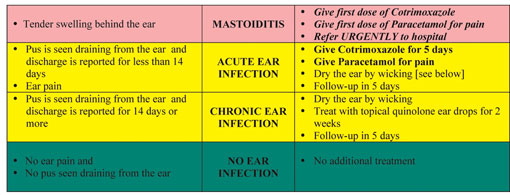Classify and treat ear problems
There are four classifications for ear problems:
- Mastoiditis
- Acute ear infection
- Chronic ear infection
- No ear infection.
Table 13.2 sets out the classification table for ear problems from the Assess and Classify chart. You can see in the top (pink) row that classification of mastoiditis requires you to give the child one dose each of cotrimoxazole and paracetamol and then refer the child urgently to hospital. The chart also outlines what treatment is required for both acute and chronic ear infection.

Table 13.2 Classification and treatment of ear problems.
You are now going to look in more detail at the different ear problems that a child might have and how you can treat these at the health post or support the mother treating them at home.
Mastoiditis
If a child has tender swelling behind the ear, classify the child as having mastoiditis.
Treatment
You must refer the child urgently to hospital. The child needs treatment with appropriate antibiotics. He may also need surgery. Before the child leaves for hospital, you should give him the first dose of an appropriate antibiotic. You should also treat his pain and high fever with paracetamol.
Acute ear infection
If you see pus draining from the ear and discharge has been present for less than two weeks, or if there is ear pain, classify the child's illness as acute ear infection.
Treatment
All children with acute or chronic ear infection should be assessed for symptomatic HIV.
Give cotrimoxazole to the child and relieve the ear pain and high fever with paracetamol. Wicking should be done to dry the pus draining from the ear; wicking is described in Study Session 14, which also describes how to counsel a mother about wicking. All Children with acute ear infection and ear discharge should be assessed for symptomatic HIV infection.
Chronic ear infection
If you see pus draining from the ear and discharge has been present for two weeks or more, classify the child's illness as chronic ear infection.
Treatment
Most bacteria that cause chronic ear infection are different from those which cause acute ear infections. The most important and effective treatment for chronic ear infection is to keep the ear dry by wicking. You should assess all children with chronic ear infection for symptomatic HIV infection.
Topical means 'applied to the outside of the body, not taken internally.'
Topical quinolone ear drops (such as ciprofloxacin solution, 0.2%) should be instilled into the ear after meticulous ear wicking, three drops three times daily for 14 days. You should show the mother how to wick the ear (see Study Session 14) and instil the ear drops and check whether she has understood the procedure.
No ear infection
If there is no ear pain and no pus is seen draining from the ear, the child's illness is classified as no ear infection. The child needs no treatment.